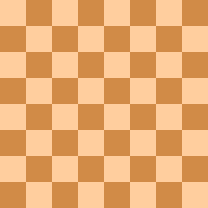
Back نهاية اللعب Arabic Endşpil Azerbaijani Эндшпіль Byelorussian Эндшпіль BE-X-OLD Ендшпил Bulgarian Final (escacs) Catalan Šachová koncovka Czech Slutspil (skak) Danish Endspiel (Schach) German Final (ajedrez) Spanish
The endgame (or ending) is the final stage of a chess game which occurs after the middlegame. It begins when few pieces are left on the board.
| a | b | c | d | e | f | g | h | ||
| 8 |  | 8 | |||||||
| 7 | 7 | ||||||||
| 6 | 6 | ||||||||
| 5 | 5 | ||||||||
| 4 | 4 | ||||||||
| 3 | 3 | ||||||||
| 2 | 2 | ||||||||
| 1 | 1 | ||||||||
| a | b | c | d | e | f | g | h | ||
The line between the middlegame and the endgame is often not clear, and may occur gradually or with a quick exchange of pieces. The endgame, however, tends to have different characteristics from the middlegame, and the players have correspondingly different strategic concerns. In particular, pawns become more important as endgames often revolve around attempts to promote a pawn by advancing it to the eighth rank. The king, which normally is kept safe during the game,[1] becomes active in the endgame, as it can help escort pawns to promotion, attack enemy pawns, protect other pieces, and restrict the movement of the enemy king. Not all chess games reach an endgame; some of them end earlier.
All chess positions with up to seven pieces on the board have been solved by endgame tablebases,[2] so the outcome (win, loss, or draw) of best play by both sides in such positions is known, and endgame textbooks teach this best play. However, most endgames are not solved, so textbooks teach useful strategies and tactics about them. The body of chess theory devoted to endgames is known as endgame theory. Compared to opening theory, which changes frequently, giving way to middlegame positions that fall in and out of popularity, endgame theory is less subject to change.
Many endgame studies have been composed; they consist of endgame positions which are solved by finding a win for White when there is no obvious way to win, or finding a draw when White appears to lose. In some compositions, the starting position would be unlikely to occur in an actual game; but if the starting position is not artificial, the composition may be incorporated into endgame theory.
Endgames are usually classified based on the type of pieces that remain.
- ^ "4 Basic Chess Opening Principles". Rafael Leitão. 2015-07-16. Retrieved 2022-12-07.
- ^ Fiekas, Niklas. "KvK – Syzygy endgame tablebases". syzygy-tables.info. Retrieved 2022-12-07.
© MMXXIII Rich X Search. We shall prevail. All rights reserved. Rich X Search